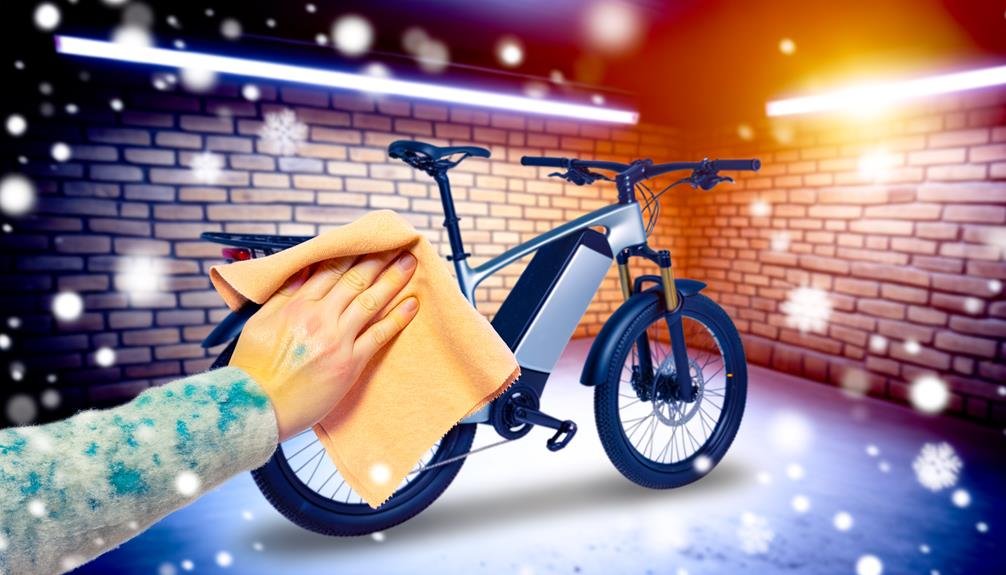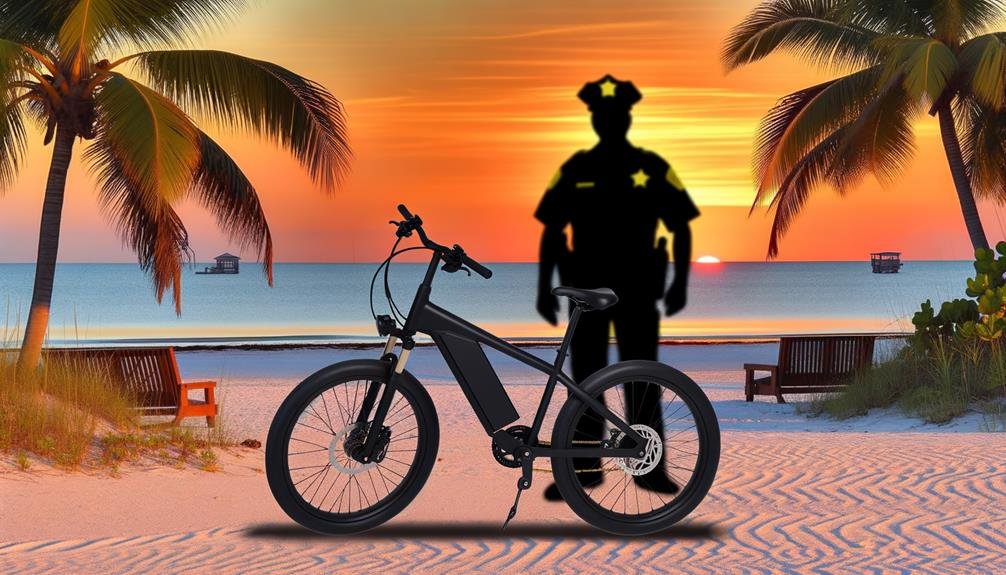Charles Miller is a veteran bike enthusiast with over 12 years of experience dealing with bikes as a mechanic. Despite immense love and expertise for...
Just as we were wondering whether it's feasible to ride an ebike in the frosty months of winter, we bet some of you are pondering the same question. It's a valid concern, given the harsh conditions that winter can bring – icy roads, freezing temperatures, and snow-covered paths.
We're here to tell you that it's not only possible, but with the right precautions, it can also be a safe and enjoyable experience. However, there are certain aspects that need to be addressed properly to ensure that your winter ebike rides are more thrilling than chilling.
Stick around as we navigate this frosty topic together.
Key Takeaways
- Winter riding on an e-bike requires specific safety measures, such as appropriate clothing and increased visibility.
- Selecting and maintaining the right winter tires is crucial for traction and stability on snow and ice.
- Proper care of the e-bike battery during cold seasons, including storing it indoors and avoiding extreme temperatures, is important for its longevity.
- Navigating snow and ice on an e-bike requires adjusting riding style and being cautious of ice patches, but fat tires can help maintain balance.
Understanding Winter Ebike Challenges
So, what're the challenges you might face when riding your e-bike in the winter?
Well, winter riding presents unique hurdles that can affect your e-bike's performance if not properly addressed. A harsh winter might increase the chances of damage to your e-bike battery due to the cold. The battery is the heart of your e-bike, and winter weather can strain this vital component. It's important to store and charge it correctly to preserve its health.
Riding conditions can also be treacherous when you ride your e-bike in the cold, especially if you're navigating through snow. Your e-bike's traction might be impacted, making your ride less stable. Regular cleaning and maintenance of your e-bike become even more crucial during winter to prevent salt and dirt buildup from impeding its performance.
Lastly, safety measures are paramount when you ride an e-bike in the snow. Ensure visibility, dress appropriately, and take extra precautions when you ride in the snow.
As a community of e-bike enthusiasts, we know these challenges can seem daunting, but with the right knowledge and preparation, they're manageable. After all, we're all in this together.
Selecting the Right Winter Tires
Having understood the challenges of winter e-bike riding, let's now turn our attention to a crucial aspect of winter preparation: selecting the right winter tires. Remember, the everyday tires that come with your e-bike aren't cut out for winter's icy and snowy conditions.
When choosing winter tires based on your riding conditions, consider these 3 key points:
- Studded tires work better for hard-packed snow and ice, while fat knobby tires excel when riding in loose, softer snow.
- For mountain bike enthusiasts, consult your dealer about adding studs to your fat tires for enhanced winter performance.
- Tire pressure is a big deal. Lower pressures provide better traction in winter. However, newbies should take a test ride without any adjustments first and proceed cautiously.
Lastly, remember that winter demands you to drive more slowly. Don't rush; safety should always be your top priority. With the right winter tires and a cautious approach, you'll find that winter e-bike riding can be a fun and rewarding experience.
Battery Care During Cold Seasons

As we delve into the heart of winter e-bike maintenance, understanding proper battery care during cold seasons becomes a crucial aspect of our discussion. We know that cold weather can be a challenge, but with the right steps, we can ensure our electric bike performs optimally even in the chilliest conditions.
Firstly, never leave your battery outside in the cold for long periods. It's best to store your ebike inside at room temperature during extreme low temperatures. This enhances not only charging but also overall performance. If your e-bike has a removable battery, bring the battery inside after your ride.
When storing your battery, avoid keeping it fully charged. Ideally, maintain it at around 50% capacity. This isn't just about immediate performance—this habit also helps prolong the lifespan of your battery. Remember to periodically check the battery charge and recharge to 50% if necessary.
In very cold weather, consider using a neoprene e-bike battery cover. This, along with bringing the battery inside when not riding, is an essential part of battery care during cold seasons. Following these guidelines will keep your e-bike in top shape all winter long.
Navigating Snow and Ice
As we venture further into winter ebiking, let's tackle the challenges of navigating snow and ice.
The importance of selecting the right winter tires and maintaining balance on icy roads can't be overstated.
We'll take a close look at these strategies, offering tips on how to safely ride your e-bike in these challenging conditions.
Winter Tire Selection
Ever wondered how to navigate icy and snowy roads on an e-bike? Selecting the right winter tires can significantly improve your traction and stability. That's why winter tire selection is crucial when riding your bike in winter conditions.
Roshan Thomas described the importance of winter tires and Power Bikes described studded models for hard-packed snow and ice.
Consider the following:
- Bikes recommends choosing winter tires specifically designed for handling ice and snow.
- Start off slow, ride more slowly than you'd in other conditions, and give yourself more time to get a feel for the terrain.
- Regularly check tire pressure for optimal traction.
Maintaining Balance on Ice
Building on the importance of winter tire selection, understanding how to maintain balance on icy conditions becomes the next crucial step in mastering winter e-bike rides. We must adjust our riding style, start off slow and acknowledge the ice patches to avoid accidents. Juiced bikes with Electrek how fat tires, due to their increased air volume, can help maintain balance as they float on the snow.
| Winter Gear | Purpose | Effect on Balance |
|---|---|---|
| Fat Tires | Increased air volume | Float on snow |
| Studded Tires | Grip on ice | Stable on hard-packed snow |
| Appropriate Apparel | Warmth and flexibility | Enhanced control |
| Bar Mitts | Protect hands | Better grip |
Storage Tips for Winter

When it comes to winter storage, we need to keep our e-bike indoors at room temperature during intense cold spells to boost charging efficiency and overall performance. This is one of the optimal storage tips for winter that we can't afford to overlook.
Storing your ebike at room temperature when temperatures drop significantly outside helps to prolong the life of the lithium-ion battery, which is a critical component of your e-bike.
Here are three key points we need to remember to effectively store an e-bike for winter:
- Remove the battery: If your e-bike has a removable battery, it's best to take it off and store it separately indoors. This prevents cold damage to the battery.
- Keep your charge: Avoid storing the battery fully charged. Instead, maintain it at about 50% to prolong its lifespan.
- Check the charge every few weeks: Over winter, periodically check the battery's charge. If it has dropped, recharge it back to around 50%.
Keeping Your Ebike Battery Warm
As we move on to the subject of keeping your Ebike battery warm, let's consider a few key points.
First, we'll discuss the importance of insulating your battery to maintain its performance during cold rides.
Then, we'll go over proper storage techniques and introduce some useful accessories to aid in battery warming.
Insulating Your Battery
To keep your e-bike battery warm and maintain stable temperatures in the winter, consider using a neoprene e-bike battery cover or warmer. This tip is especially helpful if you're using your e-bike for winter commuting. Insulating your battery is crucial to preserve its lifespan and ensure optimal performance.
Based on advice from the electric bicycle company Biktrixs, we've compiled three key steps to keeping your e-bike battery warm:
- Never leave the battery outside if the temperature is below freezing.
- Always store the battery indoors at room temperature when not in use.
- Maintain the battery's charge at about 50% when storing.
Proper Storage Techniques
Building on the idea of insulating your battery, let's now explore specific storage techniques to keep your e-bike battery warm during the chillier months.
If your e-bike has a removable battery, it's ideal to bring the bike inside at room temperature. This not only offers extra protection from rain and snow but also prevents the battery from cold damage.
A significant thing to remember is that a battery will self-discharge over time, so a partial charge is a good idea; avoid storing it fully charged. It's best to maintain around a 50% charge and top it up every so often.
Adhering to these proper storage techniques ensures your e-bike's battery remains in optimal condition, ready for your next winter ride.
Battery Warming Accessories
Investing in battery warming accessories, such as a neoprene e-bike battery cover, can be the key to maintaining stable temperatures and ensuring your e-bike's optimal performance during the winter months. Riding less in winter isn't your only option. As the bike company VanMoof explained, a battery when its temperature outside hit an extreme low can still function well with the right care.
- Use battery warming accessories: They help maintain the battery's temperature when temperatures outside plummet.
- Heat-shrink your cable connections: This prevents moisture penetration and potential freezing.
- Monitor your battery's temperature: One night sitting outside won't kill your battery, but consistent exposure to extreme cold can.
These steps allow your battery to charge better and take you further, even in the coldest conditions.
Safety Measures for Winter Rides
Navigating safely through the winter months on an e-bike requires a handful of crucial precautions. These include meticulous battery care, regular cleaning to remove corrosive substances, appropriate tire selection, and strategic changes to your riding style.
When temperatures outside hit an extreme low, it's important to wipe down your e-bike after riding to remove any salty mud or snow. This helps avoid corrosion and is appreciated by your entire e-bike.
Choosing the right tires is also vital for winter rides. We recommend choosing winter tires, which provide better traction on icy or snowy roads. Remember, on slippery surfaces, rubber just doesn't grip as well. It tends to float, reducing your control and increasing the time for braking.
Further safety measures for winter rides include adapting your riding style. Avoid sharp turns and sudden stops on icy or wet roads. If you're used to speeding down dry pavement, winter may require a slower pace.
Lastly, proper attire can make a difference when you ride an ebike in the winter. Dress in layers, choose water-resistant gloves and shoes, and consider a tube scarf or balaclava in extreme cold. These precautions will ensure a safe, enjoyable winter e-bike experience.
Frequently Asked Questions
How Cold Is Too Cold for an Ebike?
We've found that below freezing, ebike battery performance dips significantly. Heated accessories, winter maintenance, and proper riding techniques help. Tire traction, battery insulation, protective gear, and indoor ebike storage also minimize cold weather damage.
Can I Ride an Electric Bike in Winter?
Yes, we can ride an ebike in winter. We'll need to focus on winter maintenance, take safety measures, monitor battery performance, use protective gear, choose winter tires, and navigate snowy, icy paths carefully.
What Temperature Is Too Cold to Ride a Bicycle?
We're often asked, "What temperature is too cold to ride a bicycle?" It's not just about the temperature. Frostbite risks, hypothermia awareness, insulating outfits, and thermal accessories play vital roles in cold weather cycling.
What Is the Best Ebike for Cold Weather?
We'd recommend an ebike with weatherproof designs, insulated frames, winter tires, and heated accessories for optimal cold weather performance. Battery longevity is crucial, so seek durability and efficient winter maintenance. Don't forget, cold may impact speed.
Conclusion
In conclusion, we believe you can indeed enjoy winter rides on your ebike with the right preparation. The juxtaposition of the biting winter cold against the thrill of navigating icy paths can be exhilarating.
However, it's crucial to prioritize battery care, choose the right tires, and follow safety measures. Don't forget, a well-maintained bike is key to enjoying those frosty rides.
So, wrap up warm, light up your bike, and embrace the winter ebike experience!

Charles Miller is a veteran bike enthusiast with over 12 years of experience dealing with bikes as a mechanic. Despite immense love and expertise for his Tacoma, he rides his Trek Ebike more. Anytime you meet him, you’ll either hear him talking about Bikes, or writing about all things bikes and cars on this blog.
More Posts


